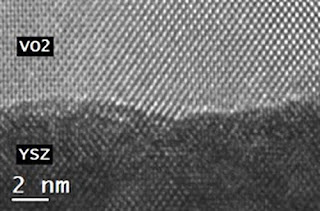“We’ve taken a sensor material called vanadium oxide and integrated it with a silicon chip,†says Dr. Jay Narayan, the John C. Fan Distinguished Chair Professor of Materials Science and Engineering at NC State and co-author of the research. “Normally sensors are hardwired to a computer. But now the sensor is part of the computer chip itself. The advantage is that now you have a smart sensor that can sense, manipulate and respond to information.â€

New findings on how "smart sensors" function gives researchers the ability to improve their reliability.(Image courtesy of Alok Gupta and J. Narayan, NC State)For example, such smart sensors allow for the development of infrared sensors that can respond more quickly in military or security applications.
The creation of these smart sensors is possible due to Narayan’s discovery of “domain matching epitaxy.†This model allows the creation of single, defect-free crystal layers of different materials â€" which amplify the transmission of electronic signals between those materials.New findings presented by a team of NC State researchers (published in Applied Physics Letters and Journal of Applied Physics) now describe how vanadium oxide sensors work in conjunction with the silicon chips to which they are attached. Understanding how these sensors function gives researchers the ability to improve the reliability of these smart sensors, and account for variable conditions the sensors may be exposed to, such as various temperatures and pressures a sensor may face in Afghanistan or Iraq.
The research, which was funded by the National Science Foundation, was co-authored by Narayan, Dr. Roger Narayan, a professor of biomedical engineering at NC State, and NC State Ph.D. students Tsung Han Yang, Ravi Aggarwal, A. Gupta, and H. Zhou. The research was presented April 7 at the 2011 Materials Research Society Spring Meeting in San Francisco. The paper, titled “Mechanism of Semiconductor Metal Transition of Vanadium Oxide Thin Films,†won the First Prize in the MRS Symposium N: Functional Oxide Nanostructures and Heterostructures.
NC State’s Department of Materials Science and Engineering is part of the university’s College of Engineering. The Department of Biomedical Engineering is a joint department under both NC State’s College of Engineering and the University of North Carolina at Chapel Hill.
North Carolina State University from NC State News Services Technical Contact: Dr. Jay Narayan, 919.515.7874 Media Contact: Matt Shipman, News Services, 919.515.6386 matt_shipman@ncsu.edu
